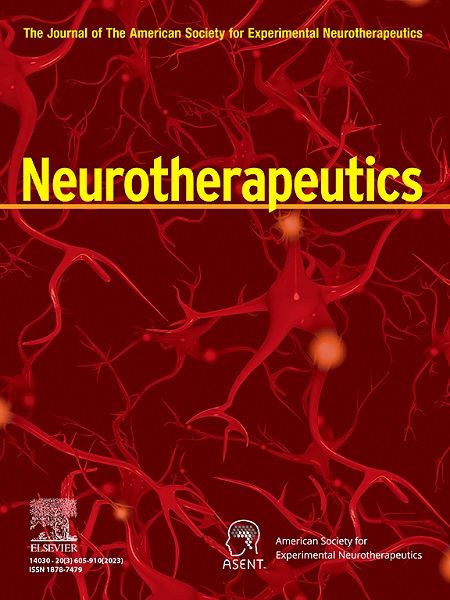Transcutaneous auricular nerve stimulation modulates the functional connectivity of the descending pain modulation system and reward network in patients with chronic low back pain
IF 6.9
2区 医学
Q1 CLINICAL NEUROLOGY
引用次数: 0
Abstract
This study aims to examine the modulatory effects of transcutaneous auricular vagus nerve stimulation (taVNS) on Chronic low back pain (cLBP). 70 cLBP patients were recruited and randomized into taVNS or transcutaneous greater auricular nerve stimulation (tGANS) group. Both interventions were administered by participants themselves after initial training (five times/week for four weeks). Magnetic resonance imaging (MRI) data were collected at baseline and after 4-week interventions. Seed-based static and dynamic functional connectivity (sFC and dFC) were performed to investigate the modulation effects on descending pain modulation system and reward network using the periaqueductal gray (PAG) and ventral tegmental area (VTA) as seeds. 51 patients (taVNS: n = 25; tGANS: n = 26) completed the study. Within-group comparisons showed a significant improvement in pain-related outcomes for both groups. Between-group comparisons revealed no significant differences. FC analysis showed that both taVNS and tGANS can increase the PAG - postcentral gyrus sFC. The taVNS is associated with increased PAG - amygdala and PAG - paracentral gyrus and decreased PAG – medial frontal cortex sFCs compared to tGANS. The present study suggest that both taVNS and tGANS can alleviate cLBP through distinct yet overlapping pathways. Our findings underscore the potential of auricular nerve stimulation as a telehealth solution for cLBP and other chronic pain conditions.
经皮耳神经刺激调节慢性腰痛患者下行疼痛调节系统和奖励网络的功能连通性。
本研究旨在探讨经皮耳迷走神经刺激(taVNS)对慢性腰痛(cLBP)的调节作用。招募70例cLBP患者,随机分为taVNS组和经皮耳大神经刺激组(tGANS)。两种干预措施均由参与者在初始训练后自行实施(每周5次,持续4周)。在基线和干预4周后收集磁共振成像(MRI)数据。采用基于种子的静态和动态功能连接(sFC和dFC)研究了以导水管周围灰质(PAG)和腹侧被皮层(VTA)为种子的下行疼痛调节系统和奖励网络的调节作用。51例(taVNS: n = 25;tGANS: n = 26)完成了研究。组内比较显示两组的疼痛相关结果均有显著改善。组间比较无显著差异。FC分析显示,taVNS和tGANS均可增加PAG -中枢后回的sFC,与tGANS相比,taVNS可增加PAG -杏仁核和PAG -中央旁回,减少PAG -内侧额叶皮层的sFC。目前的研究表明,taVNS和tGANS都可以通过不同但重叠的途径缓解cLBP。我们的研究结果强调了耳神经刺激作为cLBP和其他慢性疼痛条件的远程医疗解决方案的潜力。
本文章由计算机程序翻译,如有差异,请以英文原文为准。
求助全文
约1分钟内获得全文
求助全文
来源期刊

Neurotherapeutics
医学-神经科学
CiteScore
11.00
自引率
3.50%
发文量
154
审稿时长
6-12 weeks
期刊介绍:
Neurotherapeutics® is the journal of the American Society for Experimental Neurotherapeutics (ASENT). Each issue provides critical reviews of an important topic relating to the treatment of neurological disorders written by international authorities.
The Journal also publishes original research articles in translational neuroscience including descriptions of cutting edge therapies that cross disciplinary lines and represent important contributions to neurotherapeutics for medical practitioners and other researchers in the field.
Neurotherapeutics ® delivers a multidisciplinary perspective on the frontiers of translational neuroscience, provides perspectives on current research and practice, and covers social and ethical as well as scientific issues.
 求助内容:
求助内容: 应助结果提醒方式:
应助结果提醒方式:


